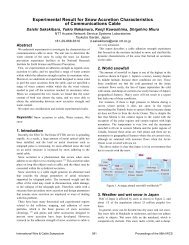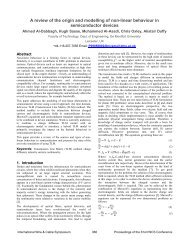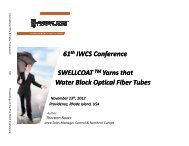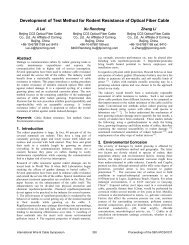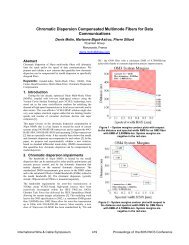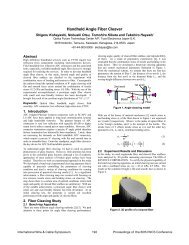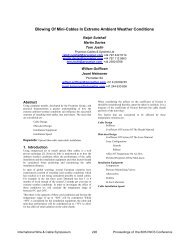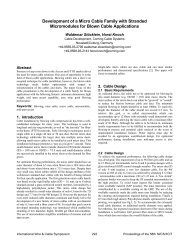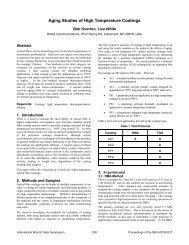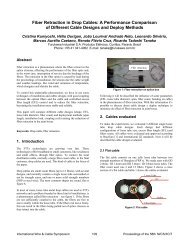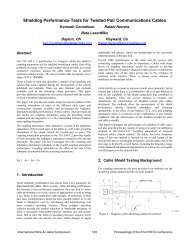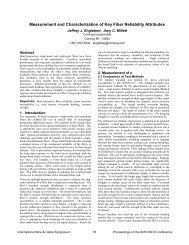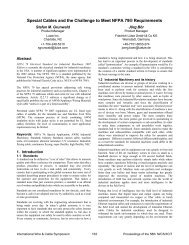Long-Term Stability of Superabsorbent Gel for Cable Water-blocking ...
Long-Term Stability of Superabsorbent Gel for Cable Water-blocking ...
Long-Term Stability of Superabsorbent Gel for Cable Water-blocking ...
Create successful ePaper yourself
Turn your PDF publications into a flip-book with our unique Google optimized e-Paper software.
<strong>Long</strong>-<strong>Term</strong> <strong>Stability</strong> <strong>of</strong> <strong>Superabsorbent</strong> <strong>Gel</strong> <strong>for</strong> <strong>Cable</strong> <strong>Water</strong>-<strong>blocking</strong>Per<strong>for</strong>manceClinton E. Clyburn IIIStewart <strong>Superabsorbent</strong>s LLCTaylorsville, NC, USA+1-828-632-5664 · kclyburn@stewartgroup.comAbstractCurrent cable water penetration requirements only examine theper<strong>for</strong>mance <strong>of</strong> water-<strong>blocking</strong> superabsorbents in a dry state,either virgin or aged. With today’s robust designs, a leak may goundetected allowing the interior <strong>of</strong> a cable to be exposed to awater head <strong>for</strong> years. In this scenario, the long-term stability <strong>of</strong>the hydrated superabsorbent gel is critical to prevent watermigration down a cable to sensitive closure electronics.This paper subjects standard superabsorbents currently used <strong>for</strong>water-<strong>blocking</strong> applications to accelerated aging tests in thehydrated state. These tests measure viscosity, flow and extrudatedrainage <strong>of</strong> the hydrated gel as a function <strong>of</strong> heat aging. Theresults are used to rank gel stability and highlight whichsuperabsorbent should per<strong>for</strong>m best <strong>for</strong> long-term blockage.The superabsorbents degraded at various rates, from total loss <strong>of</strong>gel integrity within 24 hours to stable gel structure <strong>for</strong> at least 14days. Given these differences in aging, it is essential to balanceinitial superabsorbent swelling per<strong>for</strong>mance with the ability <strong>of</strong> thesuperabsorbent to maintain water-<strong>blocking</strong> ability over time.Keywords: <strong>Superabsorbent</strong>; <strong>Water</strong>-Blocking; Dry; Aging; Heat<strong>Stability</strong>; <strong>Water</strong> Penetration.IntroductionDry water-<strong>blocking</strong> materials <strong>for</strong> cables come in many <strong>for</strong>ms,including powder, coatings, binders and tapes. They all use acrosslinked acrylate polymer as their active ingredient. Thissuperabsorbent polymer has a high affinity <strong>for</strong> aqueous-basedliquids and can absorb over 300 times its weight in distilled water.Since the 1990’s, dry water-<strong>blocking</strong> materials have beenincorporated into cable designs, including fiber optic and powerconduction constructions. These materials are tasked to stop theaxial penetration <strong>of</strong> liquid from a damaged outer jacket or splice. Inpower cables, water-<strong>blocking</strong> materials have replaced masticsaround the conductors and concentric wires. Initially used outside <strong>of</strong>buffer and core tubes in fiber optic cables to replace floodingcompounds, dry materials have migrated inside the tubes around theoptical fibers. They are found in virtually all outdoor optical cablestoday.The benefits <strong>of</strong> using dry water-<strong>blocking</strong> materials to replacemastics, flooding and filling compounds are numerous. Foremostare cost savings in cable manufacturing and installation.<strong>Superabsorbent</strong>s are so effective, the volume required in a cable isa fraction <strong>of</strong> the compound it replaces. <strong>Cable</strong> weights aresubstantially reduced and diameters <strong>of</strong>ten decreased, resulting ineasier pulls into conduits. Installation, handling and splices arevastly simplified, as compounds do not need to be cleaned.Investigations <strong>of</strong> dry water-<strong>blocking</strong> materials in cable designshave been presented multiple times in the past. The consensus <strong>of</strong>these various studies is that dry cable designs typically improvethe prior art <strong>for</strong> the a<strong>for</strong>ementioned reasons and meet currentcable per<strong>for</strong>mance standards. These standards measure theper<strong>for</strong>mance <strong>of</strong> the superabsorbent in a dry, virgin state, prior toactivation by water from cable damage. This certainly hasrelevance in the ability <strong>of</strong> the materials to immediately stop water.What has not been examined is the ability <strong>of</strong> the superabsorbent tohold the water over time once activated.Current Requirements<strong>Water</strong> penetration requirements vary depending on the cable typeand application. Outdoor fiber optic cables are typically governedby Telcordia GR-20 and FOTP-82 which allow a maximum axialpenetration <strong>of</strong> one meter when exposing the cable cross section toa one meter pressure head <strong>of</strong> water. Energy cables have a similarrequirement, one meter <strong>of</strong> cable exposed to 3-5 psi <strong>of</strong> water.GR-20 outlines water penetration testing <strong>of</strong> fiber optic cables inan unaged state and after an accelerated aging program <strong>of</strong> -40°Cto 70°C <strong>for</strong> two cycles, 168 hours at 85°C, followed by two morecycles. The accelerated aging is designed to mimic the cablelifespan <strong>of</strong> 20 years. The water-<strong>blocking</strong> materials are aged in adry state inside the cable be<strong>for</strong>e being exposed to water.IssuePrevious studies have shown some superabsorbent polymers to bequite stable in a dry state under aging at 80°C. They are stillcapable <strong>of</strong> meeting water penetration requirements afterprolonged heat exposure. Other superabsorbents showdegradation in per<strong>for</strong>mance after aging, typically in reductions <strong>of</strong>swell height and capacity to absorb water. These are usuallysuperabsorbents characterized by initial high swell capacities andexpansion ratios. Conventional thinking in the industry is thatthose superabsorbents that absorb more and at a faster rate arebetter candidates <strong>for</strong> use in cables. However, testing has shownthat the actual penetration distance in a cable does not dependsolely on the swelling speed or expansion <strong>of</strong> the superabsorbent –other characteristics <strong>of</strong> the polymer (and its carrier) are importantfactors. This said, the proper selection <strong>of</strong> material can ensurelong-term dry per<strong>for</strong>mance if a cable jacket is cut many yearsafter installation.<strong>Cable</strong> constructions today are quite robust. The sheath <strong>of</strong> a cablecan be cut without disturbing the optical fibers or conductors inside.As long as the transmission is satisfactory, the cut can go undetectedand the outside water head will be present at this cut <strong>for</strong> the life <strong>of</strong>the cable.Of course, the larger fear would be the travel <strong>of</strong> water to a junctionwhere sensitive electronics are present. The long-term stability <strong>of</strong>International Wire & <strong>Cable</strong> Symposium 147 Proceedings <strong>of</strong> the 59th IWCS/IICIT
diaper/hygiene market, hydrolytic stability <strong>of</strong> the crosslinker isnot a major concern. These materials see a short service life <strong>of</strong>less than one day upon which they are disposed and replaced.Only a superabsorbent chemically tailored <strong>for</strong> hydrated stabilitywould use an appropriate crosslinker.Shape <strong>of</strong> the expanded superabsorbent can also have an impact.The jagged edges <strong>of</strong> the crystalline particles lodge to each othermore than spheres or cauliflower morphologies, resulting in betterviscosity and flow numbers. Even as the gel ages, this increasedresistance to movement can help in prolonging superior testresults and water-blockage.Chart 3. <strong>Gel</strong> mass lost from agingDiscussionPopular superabsorbents currently available <strong>for</strong> cable water<strong>blocking</strong>applications were sampled. These were superabsorbentsfound in water-<strong>blocking</strong> tapes, yarns/binders or applied directlysuch as with electrostatic applicators. The samples originatedfrom either solution or suspension polymerization, displayingvarious morphologies including spheres, porous structures andjagged shapes. The samples contained various types and levels <strong>of</strong>crosslinking, indirectly characterized by their absorption capacity.To maintain blockage over time in an undetected jacket cut, thepremise is that the superabsorbent hydrated gel must continue tobehave similar to its initial <strong>for</strong>m and maintain a gel-type state.Degradation over time will allow liquid to penetrate past theblockage and progress further down the cable. This eventuallywill reach junctions with sensitive components such as repeatersand amplifiers reside, causing loss <strong>of</strong> service.To measure this aging integrity characteristic, three tests weredesigned to determine gel viscosity, flow and liquid/extrudateloss. Samples were hydrated to 50% <strong>of</strong> their maximumabsorption capacity in deionized water. Note that at only 50%hydration, a superabsorbent still has a significant hold onabsorbed water such that it requires a strong input <strong>of</strong> energy t<strong>of</strong>ree this moisture. Also, note that the testing medium wasdeionized water, presenting the most favorable conditions <strong>for</strong> gel<strong>for</strong>mation and retention. As it is known that ionic contentsdegrade superabsorbent swell per<strong>for</strong>mance, their presence in ahydrated aging study would likely magnify the results <strong>of</strong>deterioration [3].Our initial hypothesis suggested the superabsorbent with thehighest degree <strong>of</strong> crosslinking would display more stability in thetests. Heat is one factor which degrades polymers and a highernumber <strong>of</strong> beginning links in the polymer network would takemore time to revert to linear <strong>for</strong>m. Results basically showed thisoutcome to be true as sample SAP-7, the most reticulatedpolymer, showed the least deviation from initial testing.In addition to crosslink density, it is thought that the type <strong>of</strong>crosslinker used in the superior per<strong>for</strong>ming superabsorbent <strong>of</strong>fersmore resistance to hydrated aging, thus holding the polymernetwork together. As most superabsorbents are produced <strong>for</strong> theConclusionsHydrated superabsorbent gel stability was examined in a number <strong>of</strong>tests. These tests were designed to characterize the integrity <strong>of</strong> thegel in accelerated aging conditions <strong>of</strong> 80°C in a closedenvironment. The goal was to extrapolate aging conditions <strong>of</strong> atypical cable service life <strong>of</strong> 20 years.Results <strong>of</strong> the tests were very consistent in ranking the integrity <strong>of</strong>the aged superabsorbent gel. By far, the worst per<strong>for</strong>mer inviscosity drop, flow and extrudate drain was a fast swellingsuspension polymer commonly found in water-<strong>blocking</strong> tapes.With a low crosslinking density and high surface areamorphology, this superabsorbent was very sensitive to hydratedaging conditions and rapidly lost its gel integrity.The best candidate was a crystalline-shaped solution polymer withthe highest degree <strong>of</strong> crosslinking density, as determined byabsorption capacity. This reticulated polymer displayed verystable per<strong>for</strong>mance through the aging study and showed littlechange in gel <strong>for</strong>mation <strong>for</strong> the first two weeks, while the othersamples suffered major degradation.For a full consideration <strong>of</strong> water-<strong>blocking</strong> per<strong>for</strong>mance employingsuperabsorbents, the proper candidate must encompass the dryswelling criteria outlined by GR-20 requirements. However, thismust be balanced by hydrated gel stability to ensure that thesuperabsorbent maintains a secure block in the case <strong>of</strong> anundetected jacket breach.AcknowledgmentsSpecial thanks to Alton Deaton and Martin Tennie <strong>of</strong> Evonik <strong>for</strong>their experimental contributions to this paper.References[1] N. Patel, “Functional Per<strong>for</strong>mance <strong>of</strong> Ocean <strong>Water</strong> BlockingTapes,” International Wire and <strong>Cable</strong> SymposiumProceedings, pp.136-146, (1998).[2] F. Buchholz and A. Graham, Modern <strong>Superabsorbent</strong> PolymerTechnology, Ed. Wiley-VCH, (1997).[3] A. Bringuier and C. Clyburn III, “Reliability <strong>of</strong> Dry<strong>Water</strong><strong>blocking</strong> Materials,” International Wire and <strong>Cable</strong>Symposium Proceedings, pp.779-787, (1996).[4] M. Gourmand and Y. Taupin, “<strong>Superabsorbent</strong> Polymers(SAP) <strong>for</strong> <strong>Cable</strong> Application, ” Index Congress 99, (1999)[5] J. Gruhn, “Characterizing and Selecting Superabsorbing <strong>Cable</strong>Components,” International Wire and <strong>Cable</strong> SymposiumProceedings, pp.126-135, (1998).International Wire & <strong>Cable</strong> Symposium 150 Proceedings <strong>of</strong> the 59th IWCS/IICIT
Clinton E. Clyburn IIIStewart <strong>Superabsorbent</strong>s LLC200 Commerce DriveTaylorsville, NC 28681 USAClinton Clyburn (Kip) received a B.S. degree in MechanicalEngineering from North Carolina State University. He previouslyworked in the R&D departments <strong>of</strong> Raychem, Alcatel and Siecorbe<strong>for</strong>e joining Stockhausen <strong>for</strong> superabsorbent development. Heis currently the Division Manager <strong>for</strong> Stewart <strong>Superabsorbent</strong>s.International Wire & <strong>Cable</strong> Symposium 151 Proceedings <strong>of</strong> the 59th IWCS/IICIT



